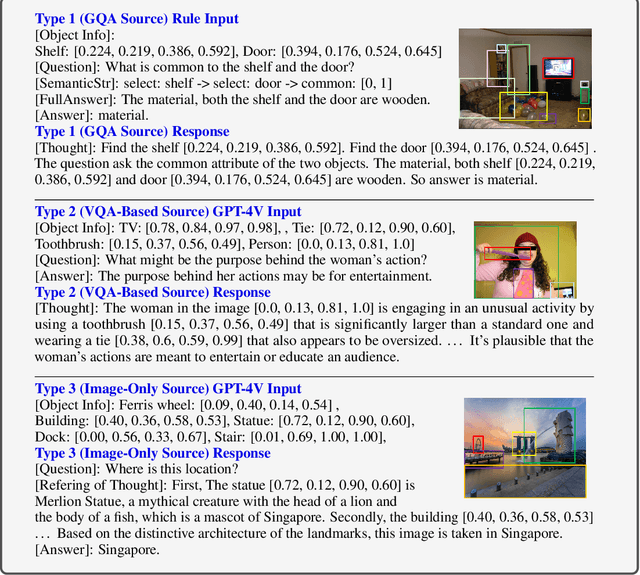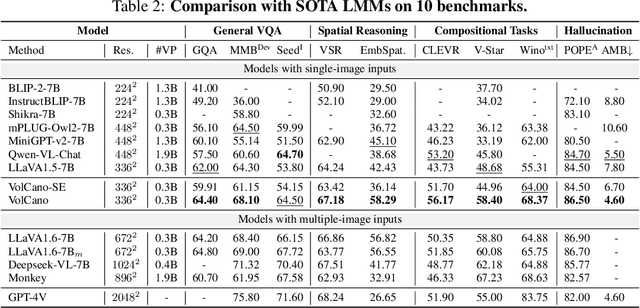Zejun Li
AutoJudger: An Agent-Driven Framework for Efficient Benchmarking of MLLMs
May 27, 2025Abstract:Evaluating multimodal large language models (MLLMs) is increasingly expensive, as the growing size and cross-modality complexity of benchmarks demand significant scoring efforts. To tackle with this difficulty, we introduce AutoJudger, an agent-driven framework for efficient and adaptive benchmarking of MLLMs that tackles this escalating cost. AutoJudger employs the Item Response Theory (IRT) to estimate the question difficulty and an autonomous evaluation agent to dynamically select the most informative test questions based on the model's real-time performance. Specifically, AutoJudger incorporates two pivotal components: a semantic-aware retrieval mechanism to ensure that selected questions cover diverse and challenging scenarios across both vision and language modalities, and a dynamic memory that maintains contextual statistics of previously evaluated questions to guide coherent and globally informed question selection throughout the evaluation process. Extensive experiments on four representative multimodal benchmarks demonstrate that our adaptive framework dramatically reduces evaluation expenses, i.e. AutoJudger uses only 4% of the data to achieve over 90% ranking accuracy with the full benchmark evaluation on MMT-Bench.
OViP: Online Vision-Language Preference Learning
May 21, 2025Abstract:Large vision-language models (LVLMs) remain vulnerable to hallucination, often generating content misaligned with visual inputs. While recent approaches advance multi-modal Direct Preference Optimization (DPO) to mitigate hallucination, they typically rely on predefined or randomly edited negative samples that fail to reflect actual model errors, limiting training efficacy. In this work, we propose an Online Vision-language Preference Learning (OViP) framework that dynamically constructs contrastive training data based on the model's own hallucinated outputs. By identifying semantic differences between sampled response pairs and synthesizing negative images using a diffusion model, OViP generates more relevant supervision signals in real time. This failure-driven training enables adaptive alignment of both textual and visual preferences. Moreover, we refine existing evaluation protocols to better capture the trade-off between hallucination suppression and expressiveness. Experiments on hallucination and general benchmarks demonstrate that OViP effectively reduces hallucinations while preserving core multi-modal capabilities.
Activating Distributed Visual Region within LLMs for Efficient and Effective Vision-Language Training and Inference
Dec 17, 2024



Abstract:Large Vision-Language Models (LVLMs) typically learn visual capacity through visual instruction tuning, involving updates to both a projector and their LLM backbones. Drawing inspiration from the concept of visual region in the human brain, we investigate the existence of an analogous \textit{visual region} within LLMs that functions as a cognitive core, and explore the possibility of efficient training of LVLMs via selective layers tuning. We use Bunny-Llama-3-8B-V for detailed experiments and LLaVA-1.5-7B and LLaVA-1.5-13B for validation across a range of visual and textual tasks. Our findings reveal that selectively updating 25\% of LLMs layers, when sparsely and uniformly distributed, can preserve nearly 99\% of visual performance while maintaining or enhancing textual task results, and also effectively reducing training time. Based on this targeted training approach, we further propose a novel visual region-based pruning paradigm, removing non-critical layers outside the visual region, which can achieve minimal performance loss. This study offers an effective and efficient strategy for LVLM training and inference by activating a layer-wise visual region within LLMs, which is consistently effective across different models and parameter scales.
EmbSpatial-Bench: Benchmarking Spatial Understanding for Embodied Tasks with Large Vision-Language Models
Jun 09, 2024Abstract:The recent rapid development of Large Vision-Language Models (LVLMs) has indicated their potential for embodied tasks.However, the critical skill of spatial understanding in embodied environments has not been thoroughly evaluated, leaving the gap between current LVLMs and qualified embodied intelligence unknown. Therefore, we construct EmbSpatial-Bench, a benchmark for evaluating embodied spatial understanding of LVLMs.The benchmark is automatically derived from embodied scenes and covers 6 spatial relationships from an egocentric perspective.Experiments expose the insufficient capacity of current LVLMs (even GPT-4V). We further present EmbSpatial-SFT, an instruction-tuning dataset designed to improve LVLMs' embodied spatial understanding.
VoCoT: Unleashing Visually Grounded Multi-Step Reasoning in Large Multi-Modal Models
May 28, 2024



Abstract:While large multi-modal models (LMMs) have exhibited impressive capabilities across diverse tasks, their effectiveness in handling complex tasks has been limited by the prevailing single-step reasoning paradigm. To this end, this paper proposes VoCoT, a multi-step Visually grounded object-centric Chain-of-Thought reasoning framework tailored for inference with LMMs. VoCoT is characterized by two key features: (1) object-centric reasoning paths that revolve around cross-modal shared object-level information, and (2) visually grounded representation of object concepts in a multi-modal interleaved and aligned manner, which effectively bridges the modality gap within LMMs during long-term generation. Additionally, we construct an instruction dataset to facilitate LMMs in adapting to reasoning with VoCoT. By introducing VoCoT into the prevalent open-source LMM architecture, we introduce VolCano. With only 7B parameters and limited input resolution, VolCano demonstrates excellent performance across various scenarios, surpassing SOTA models, including GPT-4V, in tasks requiring complex reasoning. Our code, data and model will be available at https://github.com/RupertLuo/VoCoT.
DELAN: Dual-Level Alignment for Vision-and-Language Navigation by Cross-Modal Contrastive Learning
Apr 02, 2024Abstract:Vision-and-Language navigation (VLN) requires an agent to navigate in unseen environment by following natural language instruction. For task completion, the agent needs to align and integrate various navigation modalities, including instruction, observation and navigation history. Existing works primarily concentrate on cross-modal attention at the fusion stage to achieve this objective. Nevertheless, modality features generated by disparate uni-encoders reside in their own spaces, leading to a decline in the quality of cross-modal fusion and decision. To address this problem, we propose a Dual-levEL AligNment (DELAN) framework by cross-modal contrastive learning. This framework is designed to align various navigation-related modalities before fusion, thereby enhancing cross-modal interaction and action decision-making. Specifically, we divide the pre-fusion alignment into dual levels: instruction-history level and landmark-observation level according to their semantic correlations. We also reconstruct a dual-level instruction for adaptation to the dual-level alignment. As the training signals for pre-fusion alignment are extremely limited, self-supervised contrastive learning strategies are employed to enforce the matching between different modalities. Our approach seamlessly integrates with the majority of existing models, resulting in improved navigation performance on various VLN benchmarks, including R2R, R4R, RxR and CVDN.
ReForm-Eval: Evaluating Large Vision Language Models via Unified Re-Formulation of Task-Oriented Benchmarks
Oct 17, 2023



Abstract:Recent years have witnessed remarkable progress in the development of large vision-language models (LVLMs). Benefiting from the strong language backbones and efficient cross-modal alignment strategies, LVLMs exhibit surprising capabilities to perceive visual signals and perform visually grounded reasoning. However, the capabilities of LVLMs have not been comprehensively and quantitatively evaluate. Most existing multi-modal benchmarks require task-oriented input-output formats, posing great challenges to automatically assess the free-form text output of LVLMs. To effectively leverage the annotations available in existing benchmarks and reduce the manual effort required for constructing new benchmarks, we propose to re-formulate existing benchmarks into unified LVLM-compatible formats. Through systematic data collection and reformulation, we present the ReForm-Eval benchmark, offering substantial data for evaluating various capabilities of LVLMs. Based on ReForm-Eval, we conduct extensive experiments, thoroughly analyze the strengths and weaknesses of existing LVLMs, and identify the underlying factors. Our benchmark and evaluation framework will be open-sourced as a cornerstone for advancing the development of LVLMs.
A Unified Continuous Learning Framework for Multi-modal Knowledge Discovery and Pre-training
Jun 11, 2022



Abstract:Multi-modal pre-training and knowledge discovery are two important research topics in multi-modal machine learning. Nevertheless, none of existing works make attempts to link knowledge discovery with knowledge guided multi-modal pre-training. In this paper, we propose to unify them into a continuous learning framework for mutual improvement. Taking the open-domain uni-modal datasets of images and texts as input, we maintain a knowledge graph as the foundation to support these two tasks. For knowledge discovery, a pre-trained model is used to identify cross-modal links on the graph. For model pre-training, the knowledge graph is used as the external knowledge to guide the model updating. These two steps are iteratively performed in our framework for continuous learning. The experimental results on MS-COCO and Flickr30K with respect to both knowledge discovery and the pre-trained model validate the effectiveness of our framework.
MVP: Multi-Stage Vision-Language Pre-Training via Multi-Level Semantic Alignment
Jan 29, 2022



Abstract:In this paper, we propose a Multi-stage Vision-language Pre-training (MVP) framework to learn cross-modality representation via multi-level semantic alignment. We introduce concepts in both modalities to construct two-level semantic representations for language and vision. Based on the multi-level input, we train the cross-modality model in two stages, namely, uni-modal learning and cross-modal learning. The former stage enforces within-modality interactions to learn multi-level semantics for each single modality. The latter stage enforces interactions across modalities via both coarse-grain and fine-grain semantic alignment tasks. Image-text matching and masked language modeling are then used to further optimize the pre-training model. Our model generates the-state-of-the-art results on several vision and language tasks.
Negative Sample is Negative in Its Own Way: Tailoring Negative Sentences for Image-Text Retrieval
Nov 05, 2021



Abstract:Matching model is essential for Image-Text Retrieval framework. Existing research usually train the model with a triplet loss and explore various strategy to retrieve hard negative sentences in the dataset. We argue that current retrieval-based negative sample construction approach is limited in the scale of the dataset thus fail to identify negative sample of high difficulty for every image. We propose our TAiloring neGative Sentences with Discrimination and Correction (TAGS-DC) to generate synthetic sentences automatically as negative samples. TAGS-DC is composed of masking and refilling to generate synthetic negative sentences with higher difficulty. To keep the difficulty during training, we mutually improve the retrieval and generation through parameter sharing. To further utilize fine-grained semantic of mismatch in the negative sentence, we propose two auxiliary tasks, namely word discrimination and word correction to improve the training. In experiments, we verify the effectiveness of our model on MS-COCO and Flickr30K compared with current state-of-the-art models and demonstrates its robustness and faithfulness in the further analysis. Our code is available in https://github.com/LibertFan/TAGS.
 Add to Chrome
Add to Chrome Add to Firefox
Add to Firefox Add to Edge
Add to Edge